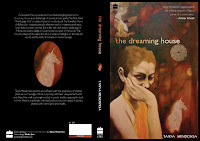The Dreaming House by Tanya Mendonsa
Reviewed by V M
There are many reasons to celebrate this week’s release of Tanya Mendonsa’s debut book of poems, ‘The Dreaming House’ at Literati Bookshop in Calangute (7pm on Thursday, December 17, 2277740).
It is a personal triumph for the poet, who calls herself a “late bloomer,” and says that her life changed forever when she moved to the ancient riverside village of Moira three years ago, after a lifetime on the move from Calcutta to Paris and back to Bangalore. Mendonsa has ancestral roots in Moira, and writes movingly that “I felt for the first time in my life that I had come home.” And there was an unexpected bonus – “from the first night in my old-new house, like a water source being unblocked, the words flowed onto paper as effortlessly as the sweet air that I breathed.”
The poems produced in that “unlocked” torrent have lasted, and have earned Tanya Mendonsa a book deal with Harper Collins, one of the leading publishing houses in India. And they have already begun to earn a buzz of appreciation from the critical establishment. The award-winning writer, Amitav Ghosh, who now spends part of the year living quite close to Mendonsa in the picturesque village of Aldona, is quoted on this well-produced book’s cover saying “Tanya Mendonsa’s work is cosmopolitan in reference, yet deeply rooted in the red earth of Goa: her Moira poems are a fitting elegy to a magical corner of a storied land.”
In a note about her work that accompanied the announcement of the release, the poet is quick to add that she hopes her poems will be a “renascence – and not an elegy as Mr. Ghosh fears.” And this is another reason to celebrate. Because Mendonsa has not simply returned to her ancestral heartland to write poetry, she has joined others to become a ferocious and determined defender of Goa’s natural and cultural heritage, and has helped to spearhead a splendid campaign that advocated carefully planned development in Moira which would ensure a sustainable future for the village’s future generations.
Mendonsa is clear that she wants “any publicity I might get for my book to make as many people as possible aware of our battle to preserve the village.” To her mind, her poetry is inextricably linked to her activism on behalf of her village’s natural and cultural heritage. She feels “a burning need to preserve the beauty around me” as it is the wellspring of her creativity, “the source of my wellbeing.” And it is true that ‘The Dreaming House’ is run through with a theme Mendonsa describes as “the poignancy of intense pleasure on the edge of loss” as in the first lines of the elegiac ‘Divorced From Green’.
One has no forewarning.
In the days of the fish and the dragonfly,
That this will not be forever.
In returning to her homeland to find serenity, meaning, and then this rush of marvellous artistry, Mendonsa confirms all of our most cherished beliefs about the singularly bewitching character of the Goan landscape. Many years ago, our great laureate Bakibab Borkar wrote a knowing essay on this very topic. “If I were to be born again, and am allowed to choose my future birth place, I shall undoubtedly opt for Goa,” declared Bakibab, “I say this not because of any blind love, but because its scenic beauty has a supernatural quality of refining the human mind, and of turning it inward into the depths of creativity and spirituality.”
Like Mendonsa, the great Bakibab was certain about the significance and impact of the sinuous beauty of our terrain on the poet’s imagination and creativity. Of “the eternal moulder of our spirit and builder of our dreams”, he warned prophetically that we must “ensure that the scenic beauty of Goa – the very foundation of our culture – is duly respected and not allowed to be marred or maimed, whatever the cost.” It is deeply moving to read and experience Tanya Mendonsa’s revival and updating of this poetic sentiment. ‘The Dreaming House’ is a significant book, and its release is an important event in Goa’s cultural history.
(ENDS)
First published in Herald, Goa (Dec 13, 2009)
Sunday, December 13, 2009
Subscribe to:
Post Comments (Atom)





No comments:
Post a Comment